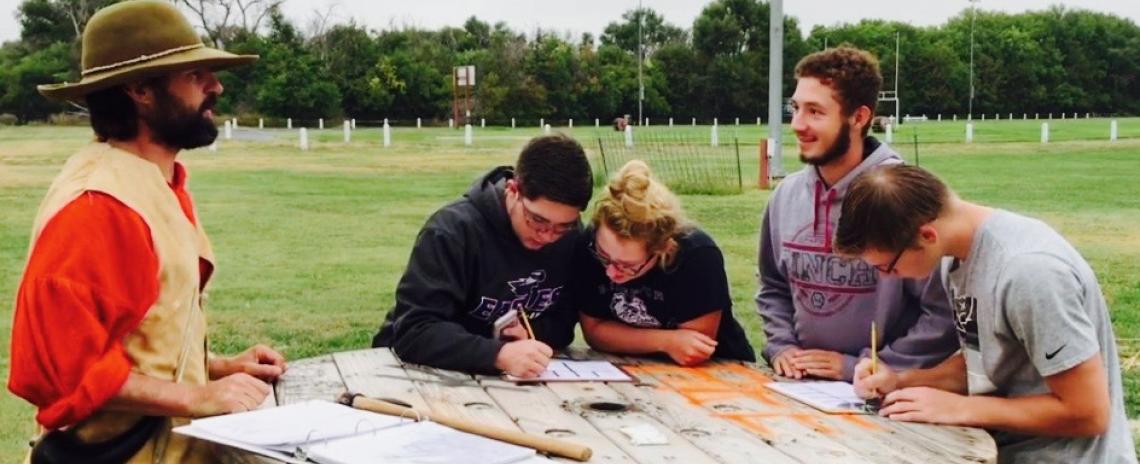Off the Page: The Land Leads the Lesson for Garden County Class
Off the Page: The Land Leads the Lesson for Garden County Class
By Tyler Dahlgren
Use your imaginations.
If history teacher Cody Assmann has one request of his Garden County students, it’s to think outside of the box.
Or, outside of the crisp pages of a textbook, rather.
Easier said than done, right? Surely drumming up imaginative spirit can be difficult, especially throughout the course of a long school day. (Or week.) (Or year.)
But for Assmann’s “Living History” class, travelling back through time to get a glimpse at the hardships of migrants navigating the Oregon Trail is made easier by the fact that, well, they’re often standing on the Oregon Trail. Literally.
“When we do mountain man lessons, we are talking about the pack trains of animals that used to follow the river we’re looking out over,” Assmann, whose class was featured by NPSA in June of 2017, said. “I’m able to tell the kids ‘Use your imaginations. Imagine 400 mules getting pushed up this river valley right where we are standing.’”
His message resonates. For Assmann, teaching at a school in the Sandhills hundreds of miles from the most-populated areas of the state is the furthest thing from a disadvantage.
It’s a world of possibilities.
“The land is part of the story,” Assmann, who grew up fascinated by the west, said. “And where we sit on the Oregon Trail, our location opens up some neat stories and some neat moments.”
Assmann talks about how the geography has changed over time, but the area hasn’t been developed nearly as extensively as other parts of the country.
“You can still use that imagination and you can still see it,” he said.
What’s it? It lives in every interactive lesson plan Assmann and his fellow Garden County teachers develop. It is the space between a power point presentation and the experience of setting foot on Ash Hollow. Or exploring the Sandhills and visioning, for an hour and a half at least, 1919 instead of 2019.
“These places haven’t changed much,” Assmann said. “I think it helps create a sense of connection for the kids. I don’t know how many of them actually get to the point of ‘Holy cow, I get what this crazy guy is saying.’ But I think it helps to get to go to the places we are talking about.”
Living History has evolved into what Assmann had imagined when, with full administrational support, he launched the model a couple of years ago. He saw his students benefit from a “fuller experience”, but wanted to offer an ulterior yet idealistically similar class that would cover more topics.
“The amount of things we were learning in Living History wasn’t very much, but the depths at which they understood them seemed to be more,” Assmann said. “I just wanted to take that and apply it to a larger scope of learning with an extended list of topics.”
And so came to be the Off the Page Education Program, which aimed to compliment academic instruction with cross-curricular activities that provide students the opportunity to explore subjects and the natural world.
For each grade level, Assmann and a couple of teachers sit down and determine unit topics. Within the unit topics come the four lessons each grade will dive into throughout the school year. All lessons, as it says in the program’s mission statement, are designed to support state standards and district goals.
For Assmann, it’s been fun to collaborate with other Garden County teachers. He’s excited about the new teachers who will be offering lessons in the second semester.
"We want to get as many people as we can involved with teaching lessons," he said.
Part of their collective challenge is coming up with 90-minute to three-hour lessons each week for grades 5-12.
“It keeps us on our toes and keeps us fresh,” he said.
The community has been on board and willing to help, much like it was when Living History was first offered.
“Our lessons do lend themselves really nicely to having community members come in and that is awesome,” Assmann said. “It has just created a lot of communication and trust, and has strengthened the relationship between the school and the community.”
Assmann has never been turned down by a community member. Every time he reaches out, whether it be to a blacksmith or a cowboy, he’s met with a willingness to help and share with students.
“Some of those guys in the pioneer lesson, like the blacksmiths for example, one of them was a bus driver, but the other blacksmith I’d never met before,” he recalls. “For him to come in and share what he knows with the kids and to teach them something he’s passionate about, it’s pretty cool to see.”
Support from the administration has been unwavering. Assmann calls himself and his fellow staff fortunate to teach in a district so open to new ideas and so committed to providing new opportunities for its students.
“You have to be willing to take some risks and try to do something unique for the kids.”


